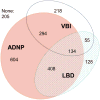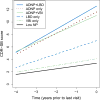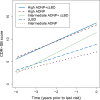Mixed neuropathologies and estimated rates of clinical progression in a large autopsy sample
- PMID: 27870939
- PMCID: PMC5438283
- DOI: 10.1016/j.jalz.2016.09.015
Mixed neuropathologies and estimated rates of clinical progression in a large autopsy sample
Abstract
Introduction: Whether co-occurring neuropathologies interact or independently affect clinical disease progression is uncertain. We estimated rates of clinical progression and tested whether associations between clinical progression and Alzheimer's disease neuropathology (ADNP) were modified by co-occurring Lewy body disease (LBD) or vascular brain injury (VBI).
Methods: Linear mixed effects models evaluated longitudinal trends in the Clinical Dementia Rating Scale Sum of Boxes on 2046 autopsied participants seen at a U.S. Alzheimer's Disease Center.
Results: Annual clinical progression was slightly faster for ADNP + LBD compared with ADNP only (P = .06) and slightly slower for ADNP + VBI (P = .003). Differences in progression were less than expected if each neuropathology independently contributed to progression; ADNP interacted with LBD (P = .002) and VBI (P = .003). In secondary models, the effect of additional pathologies on clinical progression was greater in those with intermediate compared with high levels of ADNP.
Discussion: The impact of co-occurring pathologies on progression may depend on severity of ADNP.
Keywords: Alzheimer's disease neuropathology; Cerebrovascular disease; Clinical progression; Lewy body disease; Mixed neuropathology.
Copyright © 2016 the Alzheimer's Association. Published by Elsevier Inc. All rights reserved.
Figures



References
-
- Attems J, Jellinger K. Neuropathological correlates of cerebral multimorbidity. Curr Alzheimer Res. 2013;10:569–77. - PubMed
-
- Snowdon DA, Greiner LH, Mortimer JA, Riley KP, Greiner PA, Markesbery WR. Brain infarction and the clinical expression of Alzheimer disease. The Nun Study. JAMA. 1997;277:813–7. - PubMed
MeSH terms
Grants and funding
- P30 AG013854/AG/NIA NIH HHS/United States
- P30 AG010124/AG/NIA NIH HHS/United States
- P50 AG023501/AG/NIA NIH HHS/United States
- P30 AG024978/AG/NIA NIH HHS/United States
- P50 AG005142/AG/NIA NIH HHS/United States
- P50 AG005131/AG/NIA NIH HHS/United States
- P30 AG010133/AG/NIA NIH HHS/United States
- P50 AG016574/AG/NIA NIH HHS/United States
- P50 AG005146/AG/NIA NIH HHS/United States
- M01 RR000334/RR/NCRR NIH HHS/United States
- P30 AG035982/AG/NIA NIH HHS/United States
- P50 AG008702/AG/NIA NIH HHS/United States
- U01 AG016976/AG/NIA NIH HHS/United States
- P30 AG008051/AG/NIA NIH HHS/United States
- P50 AG005681/AG/NIA NIH HHS/United States
- P30 AG013846/AG/NIA NIH HHS/United States
- P50 AG047270/AG/NIA NIH HHS/United States
- R01 AG024059/AG/NIA NIH HHS/United States
- P50 AG005136/AG/NIA NIH HHS/United States
- P30 AG012300/AG/NIA NIH HHS/United States
- P50 AG016573/AG/NIA NIH HHS/United States
- P50 AG047266/AG/NIA NIH HHS/United States
- P50 AG016570/AG/NIA NIH HHS/United States
- P50 AG005134/AG/NIA NIH HHS/United States
- P30 AG008017/AG/NIA NIH HHS/United States
- P30 AG010161/AG/NIA NIH HHS/United States
- P50 AG025688/AG/NIA NIH HHS/United States
- P50 AG005133/AG/NIA NIH HHS/United States
- P50 AG005138/AG/NIA NIH HHS/United States
- P50 AG047366/AG/NIA NIH HHS/United States
- P30 AG010129/AG/NIA NIH HHS/United States
- P30 AG019610/AG/NIA NIH HHS/United States
- UL1 RR024140/RR/NCRR NIH HHS/United States
- P30 AG028383/AG/NIA NIH HHS/United States
- P50 AG033514/AG/NIA NIH HHS/United States
LinkOut - more resources
Full Text Sources
Other Literature Sources
Medical

